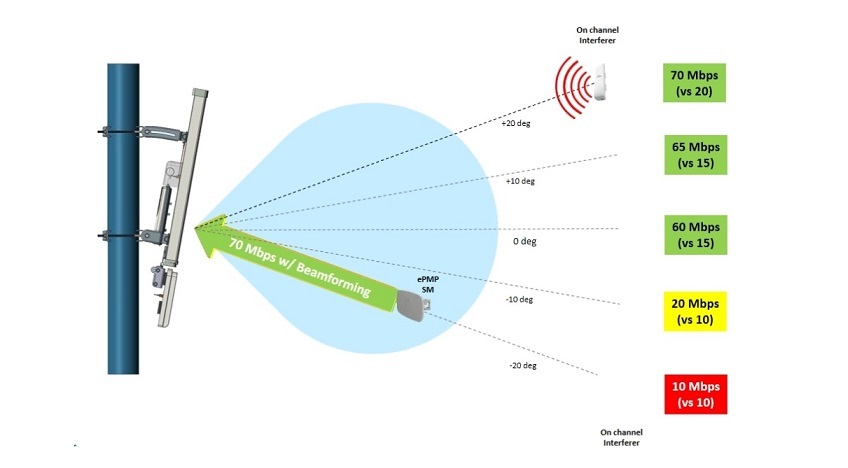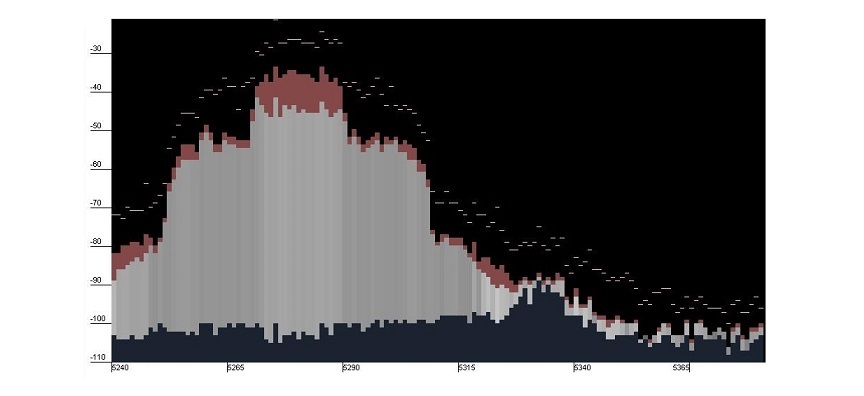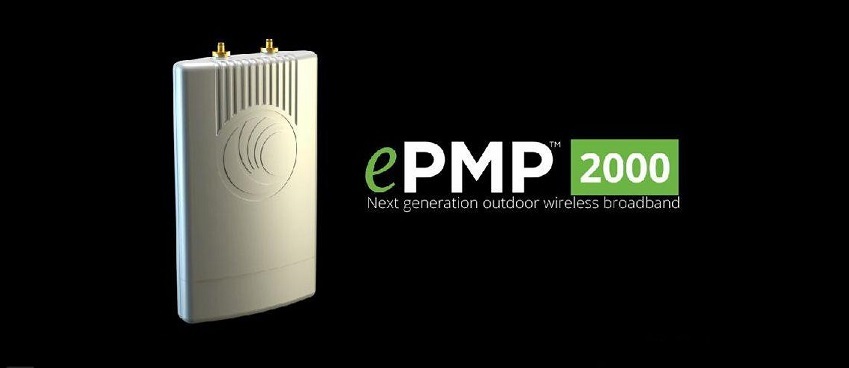Cambium ePMP 2000. Solving the problem of interference at base stations

In an ideal world, the range and performance of radio communication channels is determined solely by the level of the signal at the receiver input. And at first glance, to improve this level and to expand the coverage area of the base station, it is enough to take a more powerful piece of hardware.
But everything is not so simple. Problem number 1: interference from neighboring sectors. Problem number 2: interference from other sources. What to do? Increase power? This will only aggravate the first problem; besides, the sources of interference can also increase the power. We had this “power race” 10 years ago in all major cities. It is impossible to leave on other frequencies - you were given specific face values.
')
In the real world, it is impossible to get rid of interference, but their negative impact can be significantly reduced.
It is for this purpose that Cambium ePMP 2000, a new generation of low-cost, carrier-grade radio access equipment, was created.
Cambium ePMP 2000 is an evolution of the ePMP1000 series and takes into account many years of operating experience, as well as the wishes of operators. Despite the low price, ePMP2000 is designed to build high-speed Triple Play radio networks with QoS support for telephony and video. The peculiarity of the ePMP2000 is the ability to work well in the conditions of interference, for which Cambium came up with several mechanisms at once, which we will discuss.
How ePMP 2000 was created
The first generation, the ePMP1000, turned out to be very popular with operators because of higher productivity than Ubiquiti at a comparable price. In addition, it was in ePMP1000 that an intersectional synchronization mechanism appeared for the first time, eliminating interference from a neighboring sector in a multi-sector base. Having solved problem # 1, Cambium set about solving problem # 2 - eliminating interference from other networks. For any interference that affects the base, immediately affects all its subscribers.
Consider the most unpleasant situation when subscribers are far from the base, and the hindrance is close. It is possible to detect such a situation in oneself even without analyzing the ether - it is enough to measure the transmission capacity, with a significant difference not in favor of uplink, the source of the problem is likely interference to the base station. How does it offer to deal with interference from neighboring ePMP 2000 networks? The variant of automatic call of the RFCs, upon detection of interference, was, of course, considered, but it was recognized as non-technological and inhumane :-)
Therefore, two technologies were developed and implemented: “Hypure” and an additional band-pass filter. Technologies complement each other, although they work in completely different ways and with different sources of interference.
Hypure or “beamforming at the reception” (the opposite of Tx beamforming at Ruckus), that is, the formation within the sector of individual receiving radiation patterns for each subscriber.
Thus, the ePMP2000 base is physically retracted from all, including equal-frequency interference, even in our sector. Depending on the angle between the subscriber and the source of interference, the gain can reach 15 dB SNR. And 15 dB SNR is two modulations or two or three times the base capacity increase!

Within the sector, at different points in time, a narrowly directed receiving beam is formed for each subscriber, which makes it possible to reduce the influence of interference and to increase work productivity.
The second technology is an additional frequency filter, which operates both at reception and at signal transmission.
Unfortunately, the spectrum signal does not end at its “official” boundaries and the source with a 20 MHz signal at frequency 5320 will interfere with our 20 MHz signal at frequency 5340.

Mask of the WiFi signal chip 20M0. Even according to the standard, shoulders are visible in neighboring frequencies, and if we have a powerful (26-30 dBm) device, then the mask will be even more vague.

In order to reduce such influence (because of which, by the way, the guard interval between the sectors of the base station was previously required), a special filter is used in the 2000 series, which cuts off out-of-band interference and allows several more important Db signal-to-noise ratios to be won.

The transition from the direct amplification circuit to the heterodyne receiver circuit significantly improves the protection against out-of-band interference.
Unlike the ePMP 1000, the 2000 base station consists of three components: an access point, a sector antenna, and an optional smart antenna, which complement each other and allow you to achieve better performance and, most importantly, for reasonable money.
If you are working in good conditions of the air, you can mount the system in a lightweight composition, without acquiring an intelligent antenna, and it will still work better than the 1000 series thanks to the out-of-band interference filter and the best hardware platform. If you have a difficult noise situation - just add an additional antenna and get a significant performance gain. And most conveniently, the 2000th platform allows you to work with existing low-cost subscriber devices EPMP 1000.
Key features of ePMP 2000:
- Hypure technology uses smart filters and Smart Beamforming capabilities, which reduce interference in real-world environments better than ever before.
- The use of existing subscriber modules of the ePMP 1000 series protects investments and facilitates the transition and upgrade of the network to ePMP 2000.
- Retains all the benefits of the ePMP 1000 series, including GPS sync and Fortify technology.
- High reliability, versatility, performance and scalability - all at an affordable price.
EPMP 2000 Access Point with Intelligent Filter System

The ePMP 2000 access point is the core of the ePMP 2000 system, which raises the system to a new level of immunity to interference, which is always present in actual conditions of the air. ePMP 2000 is a combination of versatility, scalability and reusable frequency reuse capabilities, thanks to built-in GPS synchronization. The ePMP 2000 system successfully works with ePMP 1000 subscriber modules deployed around the world (including Force 180 and Force 200 series devices). This protects the investments of telecom operators and corporate customers, allowing you to increase the performance of a substantial network without the need for additional work at the installation sites of subscriber units.
- Support up to 120 clients per sector
- Frequencies 5.10 - 5.97 GHz
- Gigabit Ethernet port
- IP55 degree of protection
Smart antenna ePMP 2000

The optional ePMP 2000 Smart Antenna implements Smart Beamforming technology - antenna beam forming and is part of the innovative Hypure technology. The antenna is designed from scratch, designed to reduce the influence of interference present in real communication networks. An antenna is not a required component, if you are sure that the network is not limited by uplink interference, then you can only use a sector antenna, without a smart antenna (but you can’t use a smart antenna without a sector antenna).
- Compatible with ePMP 2000 devices only
- Frequency 5.10 - 5.97 GHz
- IP65 protection
EPMP sector antenna

The new compact antenna is suitable for all access points of the ePMP series (including the 1000 series), including the ePMP 2000 Smart Antenna, has an even better ratio of the main and back lobes of the radiation pattern (Front-to-Back Ratio) 35 dB in a wide frequency range . The sector antenna has a flat central lobe pattern (null fill), which gives the best quality of service to subscribers. All factors together allow for a simple and reliable installation of the antenna system. The manufacturer does not recommend the use of EPMP 2000 on third-party antennas and 1000-series antennas. And the fasteners on the 1000th antennas are different.
- Gain 18 dBi
- Frequency 4.90 - 5.97 GHz
- Back radiation rate 35 dB
- IP67 degree of protection
- Service angle 90 or 120 degrees
| Parameter | Antenna base ePMP1000 | Antenna base ePMP2000 |
| Gain | 18 dBi | 18 dBi |
| Ratio of front to back | 30 db | 35 db |
| Frequencies | 4.90 - 5.97 GHz | 4.90 - 5.97 GHz |
| Mount for ePMP 1000 | Yes | Yes |
| Mount for ePMP 2000 | Not | Yes |
EPMP 2000 system

System in maximum configuration: active system and two antennas, as a result, maximum configuration, which gives telecom operators and their customers such advantages as scalability, reliable operation and access to a completely new level in the fight against interference.

The same system is disassembled (the mast is not attached).
Innovative ePMP 2000 technology
Hypure
This technology consists of Smart Beamforming and intelligent filtering. In general, Hypure is an innovation designed to keep the network working in a difficult jamming environment.
Compatibility
Use of already tested in operation and deployed worldwide ePMP 1000 subscriber modules, Force 180 and Force 200 with new ePMP 2000 modules.
Frequency Reuse
Thanks to frequency reuse and GPS synchronization, ePMP allows users to easily scale the network, and where other manufacturers cannot.
Scalability
An advanced mechanism for scaling and network planning allows you to connect up to 120 subscribers per sector without degrading the overall system performance.
Quality of service
The configuration options for system and service levels give the operator the ability to support a wide range of network services — exactly the kind that customers expect, including voice and even video broadcasting.
Flexibility
A wide range of modes of operation allow you to select individual network settings.
Structural strength
The robust industrial design of ePMP devices and components allows the system to operate in all climatic conditions at operating temperatures from -30 to +60 degrees Celsius.

ePMP 2000 in all angles (rotate 360 degrees): http://bcove.me/0ukbgnim
In the near future, we will conduct tests on a real wireless network in Moscow and tell you about the results. Already, ePMP 2000 networks are deployed in Italy, where operators have seen serious gains in speed and capacity.

Now this tower delivers not only water, but also the Internet.
Tests of ePMP 1000 and ePMP 2000 equipment under interference in the direction of the base station in non-overlapping and intersecting frequencies.
| Equipment | Downlink traffic, Mbps | Upstream traffic, Mbps |
| ePMP 1000, pure ether | 94.88 | 85.09 |
| ePMP 1000, interference in its channel | 65,81 | 5.77 |
| ePMP 1000, adjacent channel interference | 94.86 | 51.67 |
| ePMP 2000, pure ether | 94.75 | 85,15 |
| ePMP 2000, interference in its channel | 71.09 | 41.16 |
| ePMP 2000, adjacent channel interference | 94.9 | 85.3 |
So, today we met with the 2000th series of ePMP - budget radio access from Cambium, and ahead we have a review of several other products, including the principled new generation, replacing the PMP450 series of radio access, promising to turn all our ideas about the capacity of communication systems. The presentation of all new radio access systems will be in September, at our conference on wireless technologies - BESEDA-19 . We are waiting for all who love radio technology as well as we.
Source: https://habr.com/ru/post/306308/
All Articles